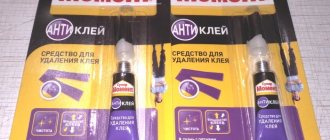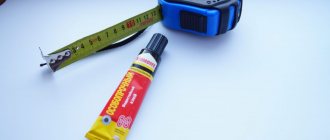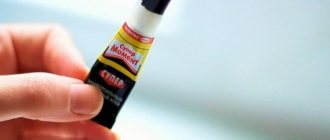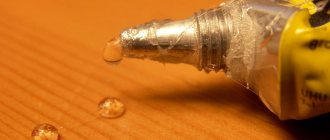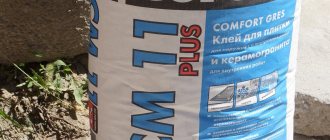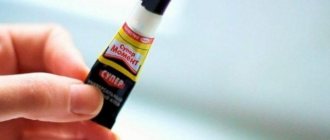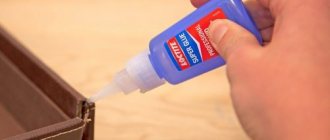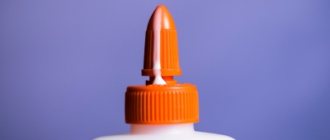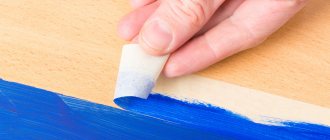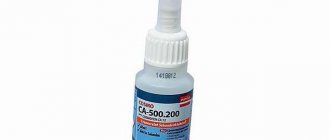Water
Water is a popular solvent. The main advantage is versatility.
The use of water is justified only if the glue is water-based. The effectiveness of the method is due to the following fact: adhesives are often water-based. However, a favorable outcome of the procedure is only possible if the glue has not had time to dry completely. Only then is it possible to remove the glue in the shortest possible time.
Wipe up excess glue with a rag, blotting the treated area with plain water. Repeat these steps until the glue disappears completely. The method will not work if the glue has dried completely.
How does superglue work?
To obtain the required degree of bonding strength of parts, second adhesives include a cyanoacrylate base. The adhesive liquid fills the small pores of the base, and from interaction with moisture present in the air, the hardening process occurs.
The clutch is reliable, resistant to water, temperature changes and mechanical loads. For this reason, it is necessary to peel off the connection as quickly as possible, before the drying of the layer is completed.
The cyanoacrylate base has minimal interaction with other elements, including solvents. For this reason, it can be difficult to find a way to remove Moment glue and other similar solutions.
The clutch is reliable, resistant to water, temperature changes and mechanical loads.
Acetone
Soak a cotton pad or rag in a small amount of liquid intended for removing varnish. Apply the soaked cotton wool to the glue and wait a few minutes. The glue will dissolve over time. Subsequently, use a stiff sponge to scrub off the softened glue. Repeat the steps until the glue is completely removed.
Acetone removes the bonding elements created between the glue and the object. The product guarantees maximum benefit when removing many types of glue. Please note: synthetic materials are vulnerable to acetone, so it is advisable to check the effect of the product on the item and then carry out the procedure.
Removing glue from different surfaces
During careless work, glue can spill onto any surface: flooring, glass table, desktop screen, shoes or clothing. It is difficult to wash off any material, be it fabric or metal. However, knowing several effective methods, you can quickly eliminate the problem.
Floor
Linoleum, tiles or carpet get dirty most often, because many people carry out repair work on the floor. When choosing a product for removing Moment glue marks, you should pay attention to the material:
- linoleum - it is better to use white spirit;
- parquet - dimethyl sulfoxide, nail polish remover, Anti-glue;
- laminate - dimethyl sulfoxide is suitable.
Attention! Parquet and laminate flooring must be treated with care so as not to damage the coating. You should definitely try the product on an invisible area of the floor. If stains or stains have formed, the substance should not be used. As for carpets, it is better to choose products specifically designed for fabric products.
Metal
Furniture and metal objects are easier to clean if they are not painted. Glue is removed with liquids that contain acetone or purified gasoline. Table vinegar removes glue well, but you need to use a concentration of 70%. As in all cases, you need to check the solvent first on a small area, because the paint may peel off the surface. In cases where traces of the Moment cannot be completely removed by anything, you can use a knife or blade to clean off the remains.
Glass
While metal can be cleaned with sandpaper or a knife, this method does not work with a window. It will immediately appear scratches that cannot be removed. It is not recommended to use acetone or other aggressive substances. It is recommended to choose the following methods:
- dishwashing gel or liquid soap;
- vegetable oil;
- White Spirit;
- solvent;
- kerosene and refined gasoline;
- ammonia.
You will need a soft sponge and rag, as well as an eraser. Instead of a knife, you need to use a plastic spatula or plasticine stack.
Note! The older the stain, the more difficult it will be to remove. Removal should begin as early as possible. It is necessary to moisten a rag in any cleaning agent and soak the glue traces generously. Do not rub too hard, otherwise the adhesive will spread to clean areas. When the glue becomes softer and more pliable, you just need to pry it with a spatula or glass and remove it from the glass.
Plastic
When gluing interior items or equipment, it is easy to leave marks on the plastic. Moment glue is similar in composition to plastic, so it is difficult to clean it without damaging the product. The surface may become matte if it was glossy, or become covered with spots or stains. Many adhesives even dissolve plastic, leaving marks that cannot be removed.
Secondary glue can be wiped off with soapy water, Anti-glue and dimethyl sulfoxide. You should wet the cloth and wipe the contaminated areas. After cleaning, many people advise polishing the surface with cleaning wipes.
MDF, chipboard and wood
Traces of glue on furniture made of natural wood or MDF and chipboard are not difficult to clean. Acetone, nail polish remover, or paint thinner will work. Soak a sponge in the liquid and treat the stains until they disappear. After that, just wipe the product with a damp cloth. The same applies to glass tables, more details here – https://tumbazakaz.ru/catalog/steklyannye-stoly
We recommend:
How to clean a leather sofa
Note! Lacquered tables, beds, chairs and other objects should not be cleaned with acetone. It is better to give preference to soap solution or oil. The special substance Anti-glue acts delicately and is quite suitable for wooden furniture.
Shoes
Often people use Moment glue to glue the sole of their shoes. As a result of careless work, the substance gets onto the skin or material, leaving stains. It is highly undesirable to resort to aggressive solutions; you need to use other tricks. How and with what can you wash Moment glue without damaging your shoes or shoes:
- wipe the surface with lemon juice;
- put the shoes in a bag and put it in the freezer for several hours (frozen glue will lose its properties and will be easy to remove);
- iron through paper or waste fabric;
- suede shoes can be cleaned gently with a brush;
- Alcohol, soap solution, solvent, Dimexide are suitable for the sole.
If you can’t wash off the glue, it’s better to take your shoes to the dry cleaner. A specialist will select a safe product and return the boots to their original appearance.
Leather Products
It is not advisable to clean leather clothes and shoes with acetone-containing products. Do not rub the surface vigorously, scrape or tear off the remaining glue with a knife. Hot soapy water, which is used to wipe the product several times, has an excellent effect. You can treat the contaminated areas with vegetable oil, and then carefully remove the remaining glue.
Ice
It is recommended to put the item that has glue on it in the freezer. The cold will take effect, after which the adhesive substance can be removed. Wait a couple of hours, wanting to achieve a decent effect. If you can't put the item in the refrigerator, use an ice pack. The glue will become brittle due to the influence of cold, as a result of which it can be easily scraped off. If you want to achieve decent results, use a special scraper that allows you to successfully remove the layer of glue.
What not to do?
To keep the table surface safe and sound, you need to act quickly and carefully with super glue. If glue ends up on the table, under no circumstances should it be smeared over the surface: it will be even more difficult to peel off a thin layer from the table.
Also, cleaning company specialists do not recommend using a knife or other sharp object: all traces of glue are unlikely to be removed in this way, but scratches will definitely remain on the table.
Do not use strong chemicals on surfaces on which food will subsequently be prepared.
REFERENCE! To reduce the mechanical impact on the surface, it is recommended to pre-soak it.
Have you ever scrubbed super glue off a table?
Not really
Anticlean
This product allows you to wash your hands of dried glue residues. When planning construction or repair activities, understanding the inevitability of contact with glue, use anti-glue, which has gained a high level of popularity. The product is sold in construction stores, so there will be no difficulties with the purchase. Anti-glue will remove glue quickly and painlessly, and it can even be used on your hands. Apply the selected product to the sponge, and then thoroughly wipe the contaminated surface. Subsequently, the stains will be successfully dissolved. Residues can be removed from fabric and natural wood without negative consequences.
By studying modern offers, you will be able to make the right choice regarding the product. A small amount will be needed to remove the adhesive. The effect will be achieved in a few minutes. The procedure requires no effort, which guarantees optimal results. Repeat the procedure if desired, as this will increase the chances of a favorable outcome.
An additional option is a special preparation designed to remove hardened glue. Modern manufacturers note the effectiveness of using the product.
After contact with skin
Method No. 1. Mechanical
- Wash your hands thoroughly with warm water and soap.
- Mix baking soda, salt and water and apply the resulting paste to your skin.
- Rub the mixture in for a couple of minutes; to speed up removal, you can use a pumice stone/nail file.
- Wash your hands again.
- If necessary, repeat the above points.
Method No. 2. Oils
If you have sensitive skin, you can use vegetable oil or margarine. Oils do not dissolve the glue, but only help to wash it off. It should be noted that super glue itself will easily come off the skin in a few days, since sebaceous secretions will “push” it off the skin.
Method No. 3. Vinegar
Acetic acid quickly destroys the adhesive composition. Safe for most surfaces.
Method No. 4. Hydrogen peroxide
An inexpensive medicine that everyone has in their medicine cabinet also helps to quickly remove hardened glue from surfaces.
The main feature of superglue
Before you wash superglue, you should figure out why it can be so difficult to clean. To create the necessary reliability of gluing, the composition uses cyanoacrylate, which practically cannot be dissolved; the substance does not react to most thinners.
Also, hardening occurs almost instantly, and it is advisable to have time to remove the drop before it dries; in a liquid state this is easier to do. After the polymerization process is completed, the adhesion strength will be very high, it will be difficult to tear off the parts fastened together, and the material itself can be damaged.
But you can still remove the layer, it is possible, the main thing is to choose the right method for the type of base.
If the glue is applied to wool or cotton, then it may be difficult to wipe off the glue, and a strong reaction may begin and cause a fire.
Hardening occurs almost instantly, and it is advisable to have time to remove the drop before it dries; in a liquid state this is easier to do.
